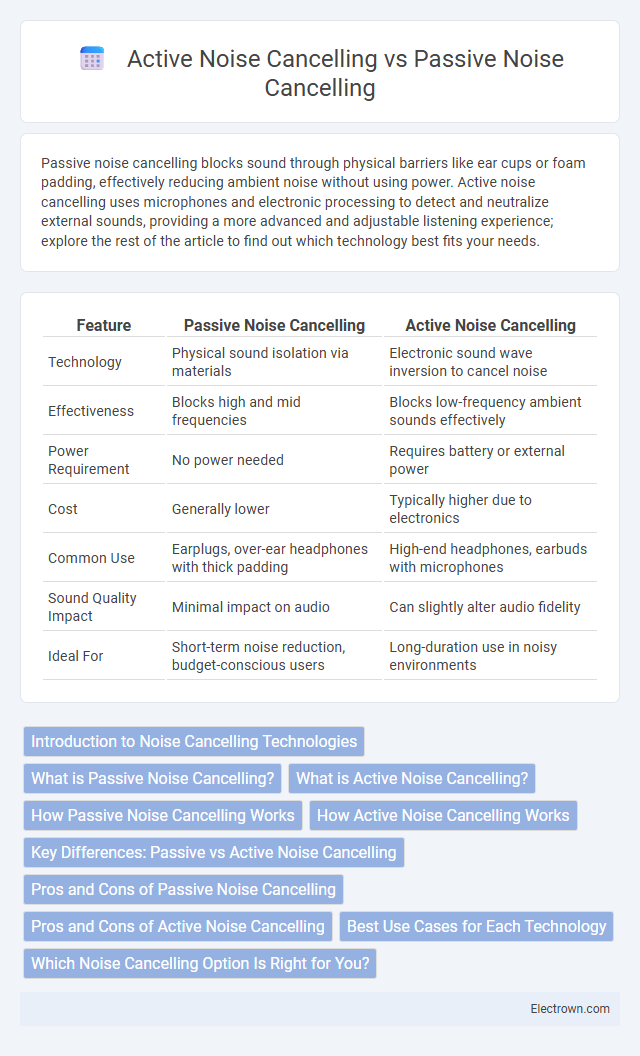Passive noise cancelling blocks sound through physical barriers like ear cups or foam padding, effectively reducing ambient noise without using power. Active noise cancelling uses microphones and electronic processing to detect and neutralize external sounds, providing a more advanced and adjustable listening experience; explore the rest of the article to find out which technology best fits your needs.
Table of Comparison
| Feature | Passive Noise Cancelling | Active Noise Cancelling |
|---|---|---|
| Technology | Physical sound isolation via materials | Electronic sound wave inversion to cancel noise |
| Effectiveness | Blocks high and mid frequencies | Blocks low-frequency ambient sounds effectively |
| Power Requirement | No power needed | Requires battery or external power |
| Cost | Generally lower | Typically higher due to electronics |
| Common Use | Earplugs, over-ear headphones with thick padding | High-end headphones, earbuds with microphones |
| Sound Quality Impact | Minimal impact on audio | Can slightly alter audio fidelity |
| Ideal For | Short-term noise reduction, budget-conscious users | Long-duration use in noisy environments |
Introduction to Noise Cancelling Technologies
Passive noise cancelling uses physical barriers like ear pads and materials to block ambient sounds, creating isolation from external noise. Active noise cancelling (ANC) employs microphones and electronic circuitry to detect and generate sound waves that cancel out unwanted noise actively. Your choice depends on environment and preference, as passive excels in blocking high-frequency sounds while ANC performs better with consistent, low-frequency noise.
What is Passive Noise Cancelling?
Passive Noise Cancelling relies on physical barriers such as ear cushions and headphones' design to block external sounds by creating a seal around or inside your ears. It does not use electronic components but instead depends on materials that absorb or block ambient noise. Your experience of quieter surroundings comes from the natural attenuation of sound waves without battery consumption or active signal processing.
What is Active Noise Cancelling?
Active Noise Cancelling (ANC) technology uses microphones and speakers to detect and counteract ambient sounds by producing sound waves with opposite phases, effectively reducing unwanted noise. Unlike Passive Noise Cancelling, which relies on physical barriers like ear cushions to block sound, ANC actively cancels external noise, improving your listening experience in noisy environments. This technology is particularly effective for low-frequency sounds such as airplane engines or traffic noise.
How Passive Noise Cancelling Works
Passive noise cancelling works by physically blocking external sounds using materials and design features such as thick ear cushions and snug-fitting ear cups that create a seal around the ears. This method relies on sound isolation, absorbing and reflecting ambient noise to reduce its penetration into the ear canal without using electronic components. Effective passive noise cancellation often depends on the quality of the materials used and the overall fit to prevent sound leakage and enhance noise reduction.
How Active Noise Cancelling Works
Active Noise Cancelling (ANC) works by using built-in microphones to detect external ambient sounds and generating sound waves with inverted frequencies to cancel out unwanted noise. This process, known as destructive interference, effectively reduces low-frequency sounds such as engine noise and hums. ANC technology requires electronic circuitry and a power source, differentiating it from Passive Noise Cancelling, which relies solely on physical barriers to block noise.
Key Differences: Passive vs Active Noise Cancelling
Passive noise cancelling relies on physical barriers such as ear cushions and materials to block external sounds, offering effective attenuation of high-frequency noise. Active noise cancelling uses built-in microphones and electronic circuitry to detect and generate sound waves that counteract low-frequency ambient noise, significantly reducing continuous background sounds like engine hum. Combining both methods often provides comprehensive noise reduction across a wider frequency range for enhanced auditory experience.
Pros and Cons of Passive Noise Cancelling
Passive Noise Cancelling relies on physical barriers like ear pads and materials to block ambient noise, offering the advantage of no battery consumption and simpler design. Its main limitation includes reduced effectiveness against low-frequency sounds compared to Active Noise Cancelling, which uses electronic processing to neutralize noise. You benefit from durability and consistent performance in various environments but may experience less immersive noise reduction in very noisy settings.
Pros and Cons of Active Noise Cancelling
Active Noise Cancelling (ANC) technology uses microphones and speakers to detect and counteract external noise, providing a significant reduction in ambient sounds, which enhances your listening experience in noisy environments like airplanes or busy streets. The primary advantage of ANC is its ability to cancel low-frequency noises effectively, but it can sometimes cause slight audio distortion and requires battery power, limiting usage time. Compared to Passive Noise Cancelling, which relies on physical barriers like ear pads to block sound, ANC offers superior noise reduction but at a higher cost and potential for increased weight in headphones.
Best Use Cases for Each Technology
Passive noise cancelling excels in environments with consistent, low-frequency sounds such as airplane cabins or crowded public transit, effectively blocking external noise through snug ear padding or isolating materials. Active noise cancelling is best suited for variable, low-frequency disruptions like engine hum, making it ideal for air travel, office spaces, and busy urban areas where adaptive sound wave cancellation enhances audio clarity. Choosing between technologies depends on specific noise environments; passive suits static noise insulation, while active provides dynamic noise suppression for immersive listening experiences.
Which Noise Cancelling Option Is Right for You?
Choosing between Passive Noise Cancelling and Active Noise Cancelling depends on your environment and usage needs; Passive Noise Cancelling uses physical barriers like ear padding to block out sound, making it ideal for low to moderate noise settings. Active Noise Cancelling technology employs microphones and electronic processing to reduce ambient noise, perfect for loud environments such as airplanes or busy offices. Your preference should consider factors like comfort, battery life, and the specific types of noise you encounter daily.
Passive Noise Cancelling vs Active Noise Cancelling Infographic

 electrown.com
electrown.com